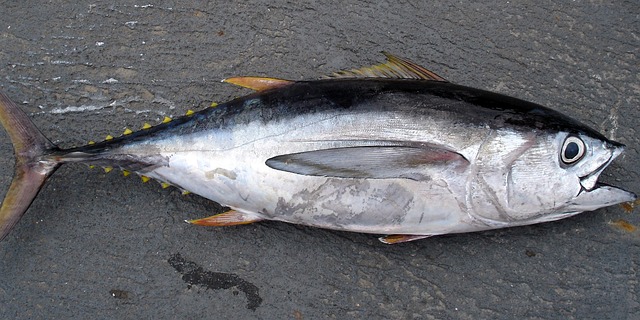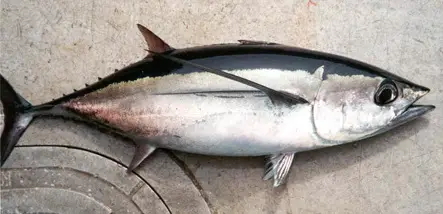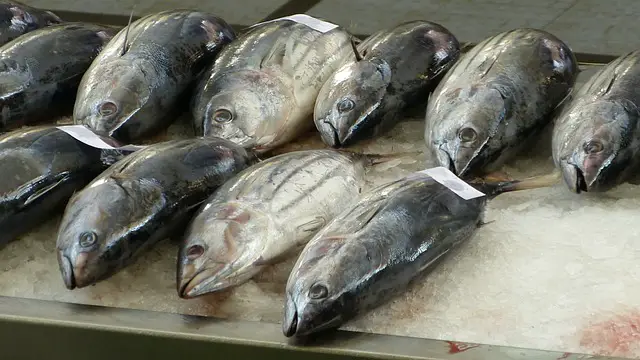Tuna is a broad term for various species. Albacore is a specific type of tuna, characterized by its white flesh and mild flavor.
TL;DR Tuna Vs. Albacore
Physically, albacore is generally larger and has a lighter-colored flesh compared to other types of tuna. It also has a milder flavor and a firmer texture.
Nutritionally, albacore tends to have higher levels of omega-3 fatty acids than other varieties of tuna. This makes it an excellent choice for those looking to boost their heart health and reduce inflammation in the body.
However, it’s worth noting that both tuna and albacore are rich sources of protein, vitamins, and minerals. They can be enjoyed as part of a healthy diet when consumed in moderation.
Tuna

Tuna refers to several species of large, fast-swimming fish found in warm seas. Belonging to the Thunnini tribe, tuna are known for their streamlined bodies, powerful tails, and migratory habits.
They are highly valued in the fishing industry for their meat, rich in protein and omega-3 fatty acids. Tuna varieties include yellowfin, skipjack, and albacore. Popular in global cuisines, tuna is consumed fresh, canned, or as sushi.
However, overfishing poses ecological challenges, prompting conservation efforts to sustain tuna populations and maintain the balance of marine ecosystems.
Albacore

Albacore, a species of tuna, is characterized by its distinctive long pectoral fins and silver-white belly. Found in both temperate and tropical oceans, it is renowned for its mild-flavored, tender, and white flesh.
Albacore is a highly sought-after fish in the culinary world, commonly used for sushi, sashimi, and canned tuna.
Due to its high-quality meat, it is often called “white tuna.” Albacore tuna undertake extensive migrations and are subject to commercial fishing. Conservation efforts aim to manage fisheries sustainably, ensuring the long-term viability of albacore populations in the world’s oceans.
Tuna Vs. Albacore – Key differences
| Aspect | Tuna | Albacore |
|---|---|---|
| Definition | Broad term for various species of fish. | Specific type of tuna (Thunnus alalunga). |
| Appearance | Various species with diverse appearances. | Distinctive long pectoral fins, silver-white belly. |
| Flavor and Texture | Flavor and texture vary among species. | Renowned for mild flavor, tender, white flesh, often called "white tuna." |
| Popular Varieties | Yellowfin, skipjack, bluefin, among others. | Albacore is a specific variety of tuna. |
| Habitat | Found in both temperate and tropical oceans. | Inhabits temperate and tropical waters, migratory habits. |
| Use in Cuisine | Consumed fresh, canned, sushi, sashimi. | Commonly used for sushi, sashimi, and prized for canned "white tuna." |
| Pectoral Fins | Varies in size and shape among species. | Distinctively long pectoral fins. |
| Meat Color | Meat color varies, can be dark or light. | Known for its light-colored, white flesh. |
| Conservation Status | Some species face overfishing challenges. | Albacore is subject to commercial fishing; conservation efforts in place. |
| Species Examples | Yellowfin tuna, skipjack tuna, bluefin tuna. | Albacore tuna (Thunnus alalunga). |
| Omega-3 Fatty Acids | Rich source of omega-3 fatty acids. | Albacore is prized for its high-quality meat and omega-3 content. |
| Culinary Use | Versatile in various cuisines worldwide. | Sought after for its mild flavor in high-end culinary dishes. |
Tuna Vs. Albacore – Physical Differences
Tuna
Species Variety:
- Tuna is a broad term encompassing various species like yellowfin, skipjack, and bluefin tuna.
Appearance:
- Varied appearances with differences in size, color, and body shape.
Pectoral Fins:
- Pectoral fins vary in size and shape among different tuna species.
Meat Color:
- The color of tuna meat can range from light to dark, depending on the species.
Flavor and Texture:
- Flavor and texture of tuna meat vary among species, from mild to rich and from firm to tender.
Albacore
Specific Tuna Type:
- Albacore is a specific type of tuna known as Thunnus alalunga.
Distinctive Appearance:
- Recognizable by its distinctive long pectoral fins and silver-white belly.
Long Pectoral Fins:
- Albacore is characterized by particularly long pectoral fins.
Meat Color:
- Albacore is known for its light-colored, white flesh.
Flavor and Texture:
- Prized for its mild flavor, tenderness, and often referred to as “white tuna.”
Tuna Vs. Albacore – Nutritional Differences
| Nutritional Component | Tuna (General) | Albacore |
|---|---|---|
| Fat Content | Varies among species; some high in fat. | Moderate fat content; leaner compared to some tuna varieties. |
| Omega-3 Fatty Acids | Rich source, promotes heart health. | Particularly rich in omega-3 fatty acids. |
| Protein | High protein content for muscle health. | Provides a significant source of protein. |
| Mercury Levels | Varies among species; some may have higher mercury levels. | Generally lower mercury levels compared to some tuna varieties. |
| Meat Color | Color varies from light to dark. | Known for light-colored, white flesh. |
| Flavor | Flavor and texture vary among species. | Prized for mild flavor, often called "white tuna." |
| Usage in Cuisine | Versatile in various cuisines worldwide. | Sought after for high-end culinary dishes, especially in sushi. |
Image Credits
Featured Image By – Alfred Koop from Pixabay
Image 1 By – WikiImages from Pixabay
Image 2 By – User:Pvmoutside, Public domain, via Wikimedia Commons








